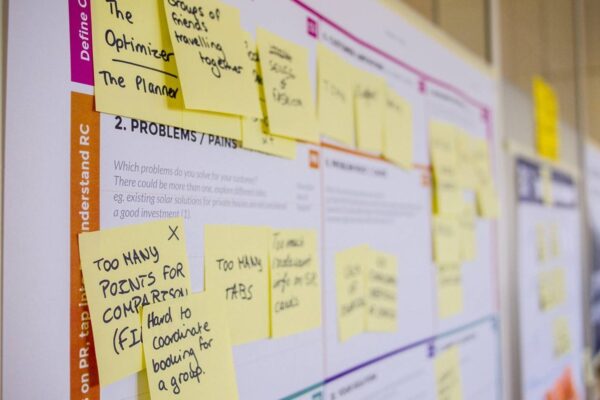
If it all happened again, could you protect the business as well as your staff? In the last twenty years we’ve had two major economic disasters, and we’ve had the chance to learn from them.
The economy is always in flux, and there is no way to schedule the next catastrophe. What leaders can do is stop reactive leadership and shift toward proactive thinking and proactively communicate it . Here are five primary ways to adopt proactive habits, proactively communicate, and move past knee-jerk reactions including Outsourcing Human Resources.
“Being proactive is more than taking initiative. It is recognizing that we are responsible for our own choices and have the freedom to choose based on principles and values rather than on moods or condition.” – Stephen Covey.

1. Setting Up for Success
Any leader can begin proactive planning with their day-to-day work. There is no need a massive two-hour 4D planning session or meeting. Small changes with consistent action and follow-through can have major impacts.
Proactive people use different methods and approaches to continue to thrive when everything starts to go downhill. The prime difference is that proactive thinkers can stop and clarify the best possible outcome and then reverse engineer the steps necessary to make that outcome as likely as possible.
Now, it’s easy to envision success when the company is at the top of its game. When you set up for success, and your daily activities reflect that, it’s easier to keep a level head when things go wrong and have a clear sight of what would count as a reasonable or acceptable outcome.
Here are four ways you can start implementing daily proactive planning.
Support Staff Knowledge on Pivoting and Response
Yes, pivot is still a buzzword and has pretty close ties to proactive planning. When setting up for success, you need to identify who on your team is best at knowing when to pivot and who is best at knowing how to pivot.
Reactive planning often involves a leader making a decision, bringing together the team to ask what they think, and then carrying out that decision. Does this sound familiar? It’s the normal way to approach planning.
Proactive planning starts with the leader listening to the team, getting organized, assessing possible responses for foreseeable changes, and exploring creative solutions. To do that, you must know who is best at each step of this process.
Teach Your Team to Plan for All Types of Weather
Setting up for success relies largely on your team and how you support them. Remember, when the going gets tough, the tough get going. So help your team become tough. You can control how you proactively communicate, build, and develop your team. Be a proactive leader.
When planning weekly, monthly, or quarterly goals, ask your staff to do the same. Ask your staff to:
- Set their work goals, and if possible, align them to team goals.
- Create a plan for the best-case scenario.
- Work out possible responses if something strays from the plan.
- Evaluate possible responses in the event of missed days or poor performance.
Audit External Factors Often
If everyone did the right thing at the right moment, there would still be many unsuccessful companies and professionals. External factors such as COVID-19 can catch all of us off-guard. Of course, the more frequently you monitor external factors, the better you can identify upcoming changes.
Conduct a SWOT (Strengths, Weaknesses, Opportunities, and Threats) analysis to review your company’s strengths, weaknesses, upcoming opportunities, and potential threats. We often perform a SWOT analysis when business planning, but leaders can benefit from regularly revisiting this tool. Use this tool to explore your position in the industry, and the current economic climate. When performing a SWOT analysis always consider the company’s financial health, legal changes, and industry disruptors.

2. Execute a Response Rather Than Delivering a Reaction
What do a toddler’s tantrum and a massive round of layoffs have in common? They are often reactionary. When anything changes in the economy, you will need to form a response. You are response-able.
There were stories of companies who opted for temporary furloughs to allow staff to access unemployment but still have the promise of returning to work. Others agreed to take pay cuts to keep more people employed.
How can you begin creating responses rather than reactions? Start considering your language.
“I can’t keep the business open if we don’t get this bid,” – becomes – “I need to close the business if we don’t attract more clients.”
“We have to let go of a lot of people,” – becomes – “We’ll let go of 20% of our staff to keep the other 80% employed.”
These seem the same and have the same outcome, but the difference is the responsibility. Take charge and own your decisions even when you feel backed into a corner.
“Proactive people are agents of change and choose not to be victims, to be reactive, or to blame others.” – Stephen Covey.
Proactive people choose the hard decision for a reason and proactively communicate it. Understanding why something must happen or the next right thing is empowering, even if it’s the only good option.
Methods to build quality responses:
- Reconsider your response time. 99% of the time, you do not need to make a decision right now. Decide to take time to formulate a response instead of going with your first reaction.
- Ask who or what is behind your initial idea. We’re influenced in many ways, always stop first and consider those influences. “Who says layoffs are the only answer?” or “Who says everyone has to keep admin in-house?”
- Talk to your conscience. Is there something you would regret doing? Is there an opportunity to hope for?
Finally, use the Solomon Paradox. This paradox is an extremely common and equally frustrating situation where we humans are great at giving advice and terrible at following our own. Look at your business and your economic situation. What would you encourage a close friend to do?

3. Become Nimble
The term “agile” has gone rogue, but there’s something unspoken and powerful about its cousin: “nimble.” To compare to the two, agility ties to dexterity, while nimble action requires swiftness and quick detection. Can you hurdle an unexpected challenge and remain on course? If so, you’re not just agile; you’re nimble.
Handling Staff with Nimble Tactics
Plan nimbly. Assess the expenses of keeping the current office space, offering ideal benefits, taxes, insurance, and more. These can all be reduced or increased based on staffing.
A business’ staff has such a dramatic financial impact that upsizing and downsizing are the most common ways to handle economic change. When business is good, you upsize and bring in more staff. Then, when times are tough, businesses downsize.
Leaders often struggle because many expenses tied in with staffing are long-term commitments. Even medium to large-size businesses struggle to adjust benefits and insurance every time they adjust their staffing.
One solution to becoming nimbler is to use outsourcing options to make payments based on current staffing levels.
Corban OneSource offers complete HR outsourcing solutions using a variable cost model. Unlike other Outsourcing Human Resources solutions, our clients only pay for the staff they have and we know that can change from one month to the next. This flexibility level allows companies to cash in on the full effects of upsizing or downsizing their staff as they proactively respond our changing economy. It also means businesses can reclaim the time and effort of managing staffing, benefits, and HR support.
Proactive Tension Resolution
It’s easy to look at new companies or extremely “agile” companies and declare that they resolve tension before it becomes toxic. The struggle, of course, is that as a company ages, their leadership methods and culture cause them to lose that. However, when looking at older and more established companies such as Xerox, it’s clear there are other ways to proactively reduce tension, and it calls for nimble leadership and proactively communicate the plan to reduce tension.
Leaders who promote and encourage nimble action within their teams cause the company to experience less tension and higher productivity. They want their staff to work with the quickness and high-detection abilities as their leaders.
Nimble companies focus on entrepreneurial, enabling, and structural-driven leadership. The result is that staff work with a high degree of self-management, which builds resilience and breeds innovative thinking. When something happens, good or bad, all the staff can make nimble decisions to reduce tension.
Planning for Compliance and Legal Matters
Few things can disrupt a company as severely as a lawsuit. One lawsuit can stop the entire legal department or HR team in their tracks and everything from payroll to onboarding must wait. When it comes to legal compliance, a company must be precise and accurate. Business leaders must hit the mark every time, because even when you walk the line, there is always the risk of a lawsuit.
Outsourcing Human Resources does offer benefits when it comes to handling compliance matters, especially in areas of the law that frequently change such as labor laws. Through outsourcing, a company can get multiple sets of eyes on payroll processing, benefits applications, and standard reporting. It’s the best chance to catch any mistake and make corrections before it becomes a legal risk.
One lawsuit can destroy a company. In the event of a mistake or potentially unfounded lawsuit, Corban OneSource maintains mega insurance. That means we’re here to support you, mitigate legal risk, and do the double-checking or careful reviews to ensure accuracy. We use pooled resources and the safety net of insurance to keep our clients safe.

4. Establish Clear Protection by Outsourcing Human Resources
32% of HR Payroll people embezzle. Isn’t that alarming? The impact of shrinkage and theft in all forms can break a company down and leave it unprepared to handle any drop in the economy.
At Corban OneSource, not only do we actively avoid embezzlement, but we look for ways to improve HR processes to get the most use out of your resources.
Protect your assets, your people, and your mission with one solution. Of course, the idea is to avoid loss whenever possible and mitigate risk as often as possible. Outsourcing your payroll reduces the chances of someone within your company embezzling. Outsourcing early onboarding can reduce the risk of unwanted practices remaining in company culture.
On the other side of protection is positive and proactive steps and proactively communicate those steps. Yes, you’re avoiding a lot, but with Outsourcing Human Resources duties, you’re also gaining quite a bit, with very little effort.
Outsourcing payroll can:
- Control costs from incorrect payroll processing
- Eliminate redundancies with payroll approvals.
- Reduce risk through enhanced legal compliance.
Outsourcing other areas of HR such as benefits administration and HR support for your staff can do even more, such as:
- Promote growth while reducing overhead.
- Identify bottlenecks.
- Support proactive planning such as succession planning.
- Build employee retention.
Reduce the risk of in-house payroll staff handling finances and data. At the same time, enable your team to work on strategic initiatives to support the company through unexpected changes.
Outsourcing allows your team to focus on their core initiatives rather than tedious but important tasks. Those initiatives can prepare a company to grow quickly when the economy is up and scale down during financial uncertainty.

5. Know Where You Have the Flexibility to Adapt to Changing Conditions
Employee benefits are often the first things to go when the economy takes a turn. Even when a single industry has a bad quarter, companies start looking at what they can cut besides their people. As you begin building your proactive plans and exploring how you can accommodate unexpected changes, it’s time to look at benefits that are overdue for a review.
Your region might require certain benefits, and other employee benefits might be perks to attract and retain top talent. But benefits are a major pain point. Here is some insight into common benefits issues:
- 35% of employees don’t fully understand their benefits. That goes up to 54% in younger employees. The result is that many benefits go unused.
- 40% of employees report their employers don’t offer benefits or programs that help.
- 91% of executives believe their employees are happy with their benefits, but that’s clearly not the case if 40% of employees believe the benefits are not helpful.
Are you offering the right employee benefits? Do your staff understand the benefits available to them? Working with proactive thinking in mind, you can better serve your business or team by only paying for benefits that contribute to employee satisfaction and benefit the company.
Don’t wait until the next economic crisis to shut down your benefits system. Instead, find out what your staff want so you can provide flexible and desirable benefits that staff will actually use. When you outsource your HR through Corban OneSource, we provide support in finding the best employee benefits available while offering unmatched flexibility with those benefits.

Are You Prepared?
The economy changes faster than you can say “stock market,” and it will only continue changing. We’re certainly all together in this when trying to thrive in the good times a succeed in keeping up our high standards in trying times.
Proactive thinking and proactively communicate the plan empowers people to build a better future for themselves, their team, or the company, no matter the external circumstances. It’s not about reframing or avoiding but instead taking accountability for producing the best response to external changes. Use proactive planning and proactively communicate it to develop your team, your company and build flexibility that allows your business to take nimble action whenever necessary.
Our services use a variable cost model based on per employee per month. You only pay for the exact number of staff you have currently. We also offer flexible employee benefits plans and management alongside all the support you need for staff to understand and get the most out of those benefits. Corban OneSource helps businesses adopt a nimble attitude while establishing a new standard on company protection planning. We are a Mid Market Human Resource Outsourcer or HRO for companies of 75 to 6,000 employees. Are you looking to outsource the core HR functions of Payroll, Benefits Administration and HR Support?Find out more here.


